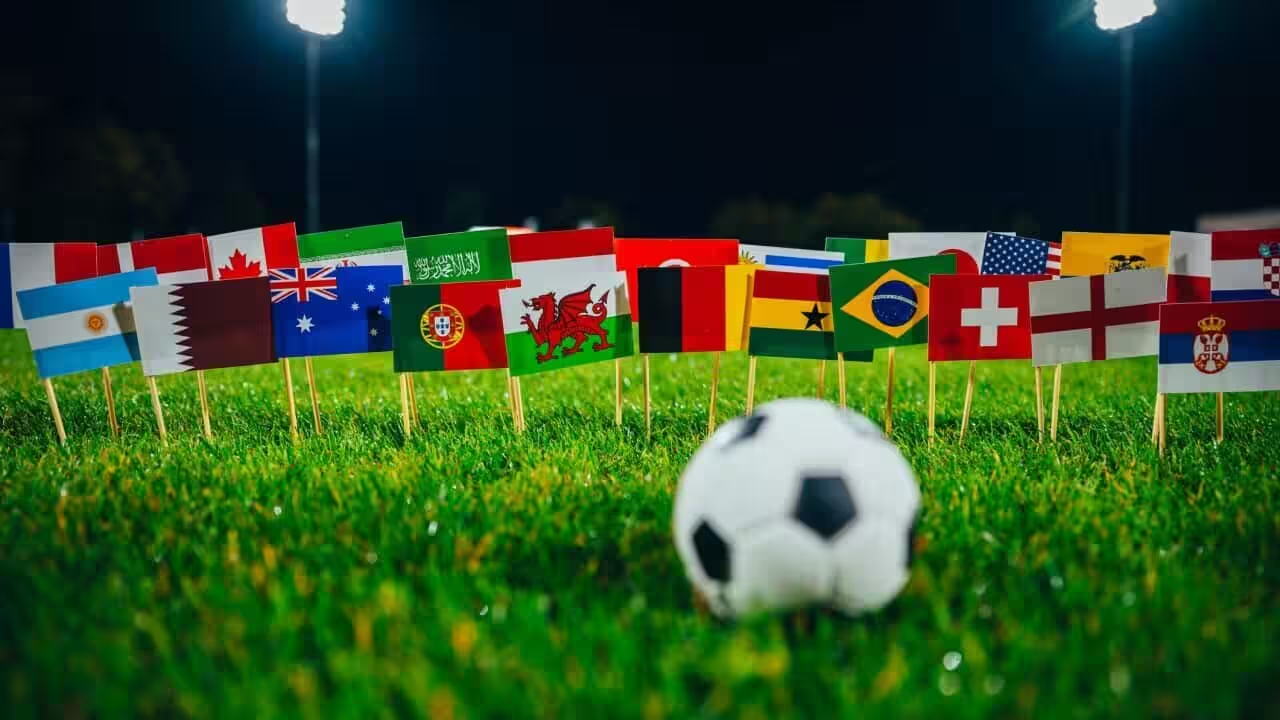The FIFA World Cup stands as the most celebrated sporting event on the planet, capturing the hearts of billions every four years. Many fans often wonder, “How many countries are in the FIFA World Cup?” The answer has changed over time, reflecting the tournament’s growth and the global reach of football. For the 2022 edition, 32 countries competed for the coveted trophy.
In 2026, the number will rise to 48, making it the largest World Cup ever. This article explains how the number of participating countries has evolved, what the upcoming expansion means, and why this matters for football fans everywhere.
The Origin of the FIFA World Cup and Its Early Format
The FIFA World Cup began in 1930 in Uruguay, marking the start of a new era for international football. Only 13 teams took part in the first edition, mostly from the Americas and Europe.
The tournament’s early years reflected the limited reach of global football at the time. Travel and communication barriers made it difficult for many nations to participate, especially those outside Europe and South America.
As football’s popularity spread, more countries wanted to join the competition. FIFA, the sport’s governing body, recognized the need to expand the tournament to reflect the growing interest. Over the decades, the World Cup has become more inclusive, with changes to the number of participating teams and the qualification process.
The early tournaments also had a unique format. Teams were divided into groups, and the winners advanced to knockout rounds. This structure allowed for a clear path to the final, but the limited number of teams meant that some continents were underrepresented. As a result, FIFA began to consider ways to make the tournament more global, ensuring that every region had a fair chance to compete.
How the Number of Countries in the FIFA World Cup Has Changed
From 13 to 16 Teams: The Early Expansions
The first World Cup featured 13 teams, but the number soon increased. By 1934, the tournament had 16 participants, a format that continued for several decades. This change allowed more European and South American teams to join, but other regions remained on the sidelines.
Between 1954 and 1978, the World Cup consistently hosted 16 teams. This period saw the rise of new football powers and the emergence of memorable matches. However, as nations from Africa, Asia, and North America developed their football programs, calls for further expansion grew louder.
The Move to 24 and Then 32 Teams
In 1982, FIFA expanded the World Cup to 24 teams. This decision gave more countries from outside Europe and South America a chance to compete. The new format introduced additional group stages and increased the excitement for fans worldwide.
By 1998, the tournament grew again, this time to 32 teams. This format allowed for greater representation from every continent. African, Asian, and North American teams began to make deeper runs in the tournament, and the global appeal of the World Cup soared.
From 1998 to 2022, the 32-team format became the standard. Each edition featured a mix of established football giants and emerging nations, creating a dynamic and unpredictable competition. The qualification process also became more competitive, with hundreds of countries vying for a spot on the world’s biggest stage.
The 2026 Expansion: 48 Teams
The most significant change in recent history comes with the 2026 World Cup. FIFA has confirmed that 48 countries will participate, making it the largest tournament ever. This expansion reflects the sport’s growing popularity and the desire to include more nations from every region.
The 2026 World Cup will be co-hosted by the United States, Canada, and Mexico. This joint hosting arrangement underscores the global nature of the event and the importance of inclusivity in modern football. The new format will feature 12 groups of four teams, with the top two from each group and the eight best third-placed teams advancing to the knockout stage.
This expansion means that more fans than ever will see their country compete on the world stage. It also presents new challenges and opportunities, as teams from smaller football nations get a chance to shine.
FIFA World Cup Qualification: How Countries Earn Their Place
Getting to the FIFA World Cup is no easy feat. With over 200 national teams registered with FIFA, the qualification process is intense and demanding. Every continent has its own path to the finals, with regional tournaments and playoffs determining which countries make the cut.
The Role of FIFA Confederations
FIFA recognizes six continental confederations, each responsible for organizing qualification tournaments:
- The Asian Football Confederation (AFC)
- The Confederation of African Football (CAF)
- The Confederation of North, Central American and Caribbean Association Football (CONCACAF)
- The South American Football Confederation (CONMEBOL)
- The Oceania Football Confederation (OFC)
- The Union of European Football Associations (UEFA)
Each confederation receives a set number of spots in the World Cup, based on the strength and size of its member nations. For example, UEFA typically receives the most spots due to the depth of European football, while OFC has the fewest.
How Qualification Works
The qualification process usually begins about three years before the World Cup. Teams compete in group stages, home-and-away matches, and playoffs. The exact format varies by confederation, but the goal is the same: to determine which countries earn a place in the finals.
For the 2022 World Cup, 32 teams qualified through this process. The host nation, Qatar, received an automatic spot. The other 31 places were filled through regional qualifiers, with fierce competition and dramatic moments along the way.
In 2026, with 48 spots available, more countries will have the opportunity to qualify. This change is expected to increase participation from Africa, Asia, and North America, giving fans from these regions more reasons to cheer.
The Impact of Expansion: What 48 Teams Means for the World Cup
The move to 48 teams in 2026 marks a bold step for FIFA and world football. This expansion brings both excitement and debate, as fans and experts weigh the pros and cons of a larger tournament.
More Representation, More Dreams
With 48 countries competing, the World Cup will showcase an even broader range of cultures and playing styles. Smaller nations that previously struggled to qualify now have a better chance to participate. This inclusivity supports FIFA’s mission to grow the game globally and inspire new generations of players and fans.
The expanded format also means more matches, more stories, and more opportunities for underdog teams to make history. Fans can expect to see fresh faces and new rivalries, adding to the tournament’s appeal.
Challenges and Criticisms
Not everyone supports the expansion. Some critics argue that increasing the number of teams could dilute the quality of play. They worry that weaker teams may struggle against traditional powerhouses, leading to one-sided matches in the early rounds.
Others point to logistical concerns, such as scheduling, travel, and stadium requirements. Hosting a 48-team tournament requires careful planning and significant resources, especially when matches take place across multiple countries.
Despite these challenges, FIFA remains committed to the expansion, believing that the benefits outweigh the drawbacks. The 2026 World Cup will serve as a test case for the future of international football.
The New Tournament Format
The 2026 World Cup will introduce a new structure to accommodate the increased number of teams. Instead of eight groups of four, there will be 12 groups of four teams each. The top two teams from each group, along with the eight best third-placed teams, will advance to the Round of 32.
This format ensures that every match matters, with more teams having a realistic shot at reaching the knockout stages. The total number of matches will rise from 64 to 104, providing fans with even more football to enjoy.
Historical Participation: Which Countries Have Played in the World Cup?
Since 1930, a total of 80 national teams have competed in the FIFA World Cup finals. Some countries, like Brazil, have become synonymous with the tournament, while others have made only a single appearance.
The Most Successful and Frequent Participants
Brazil stands out as the only country to have played in every World Cup edition. With five titles, Brazil also holds the record for the most championships. Germany and Italy follow closely, with four titles each. Argentina, the current champions, have won three times.
Other notable winners include France, Uruguay, England, and Spain. These nations have left a lasting mark on World Cup history, producing legendary players and unforgettable moments.
Countries Making Their Debut
Every World Cup introduces new teams to the global stage. In recent years, countries like Iceland and Panama have made their first appearances, thrilling fans with their passion and determination. The expansion to 48 teams in 2026 will likely see even more nations make their debut, further enriching the tournament’s diversity.
World Cup Winners List
| Country | Titles | Years Won |
|---|---|---|
| Brazil | 5 | 1958, 1962, 1970, 1994, 2002 |
| Germany | 4 | 1954, 1974, 1990, 2014 |
| Italy | 4 | 1934, 1938, 1982, 2006 |
| Argentina | 3 | 1978, 1986, 2022 |
| France | 2 | 1998, 2018 |
| Uruguay | 2 | 1930, 1950 |
| England | 1 | 1966 |
| Spain | 1 | 2010 |
Frequently Asked Questions
1. How many countries will compete in the 2026 FIFA World Cup?
The 2026 FIFA World Cup will feature 48 countries, making it the largest tournament in history. This expansion allows more nations from every continent to participate and increases the excitement for fans worldwide.
2. How many teams played in the 2022 FIFA World Cup?
The 2022 FIFA World Cup in Qatar had 32 teams. This format had been in place since 1998, providing a balanced competition and representation from all six FIFA confederations.
3. Why did FIFA decide to expand the World Cup to 48 teams?
FIFA expanded the World Cup to 48 teams to promote inclusivity and give more countries a chance to compete. The decision reflects the growing popularity of football and the desire to involve more regions in the tournament.
4. How does a country qualify for the FIFA World Cup?
Countries qualify for the World Cup through regional tournaments organized by their respective FIFA confederations. The qualification process involves group stages, playoffs, and sometimes intercontinental matches to determine the final list of participants.
5. Which country has appeared in every FIFA World Cup?
Brazil is the only country to have participated in every FIFA World Cup since the tournament began in 1930. Brazil also holds the record for the most World Cup titles, with five championships.
6. Can countries that are not fully independent compete in the World Cup?
Yes, some territories and regions, such as Scotland and Hong Kong, have their own national teams and can compete in the World Cup if they qualify. FIFA membership is the key requirement for participation, not full political independence.
7. How many countries have won the FIFA World Cup?
Eight countries have won the FIFA World Cup: Brazil, Germany, Italy, Argentina, France, Uruguay, England, and Spain. These nations have produced some of the most memorable moments in football history.
8. What is the format of the 2026 FIFA World Cup?
The 2026 World Cup will have 12 groups of four teams each. The top two teams from each group, along with the eight best third-placed teams, will advance to the Round of 32, followed by knockout rounds leading to the final.
9. How many FIFA member associations are there?
FIFA has 211 member associations, more than the number of countries recognized by the United Nations. This includes some territories and regions that are not fully independent countries.
10. What are the benefits of hosting the FIFA World Cup?
Hosting the World Cup brings economic, social, and cultural benefits. It boosts tourism, creates jobs, and enhances a country’s global profile. The tournament also unites people and inspires future generations of football players.













